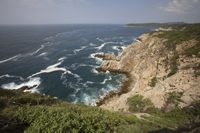World Bank Calibrating its Measurement of Sustainability

The World Bank is working to update the mechanisms it uses to measure the effects of the financing it provides, particularly in environmental and social terms, now that it is gearing up to administer the new Green Climate Fund.
'The Bank is working to deepen the measurement of impacts,' not only 'the outcomes associated with a project, but also its long-term effects, such as impacts on health, ecosystems or the quality of life of the population,' Gustavo Saltiel, the director of sustainable development for the World Bank in Mexico, told Tierramérica.
The World Bank is one of the leading financers of environmental projects in Mexico, as well as projects to combat climate change since 2009.
Since 1999, the multilateral institution has disbursed 672 million dollars in loans for 43 projects in Mexico aimed at developing the low-carbon economy, energy efficiency, renewable energies, sustainable transportation, and improved air quality.
But the results of these projects and the transparency with which these funds are used by the Mexican authorities have been questioned by civil society organisations.
The World Bank has established safeguard policies to 'promote socially and environmentally sustainable approaches to development as well as to ensure that Bank operations do not harm people and the environment,' according to its website.
These safeguard policies include the Bank's policy on environmental assessment of loan proposals and the corresponding safeguards regarding cultural property, disputed areas, forestry, indigenous peoples, international waterways, involuntary resettlement, natural habitats, pest management and safety of dams.
Evaluations of these policies 'have demonstrated the poor work done (by the Bank) in monitoring the execution of measures to mitigate social and environmental risks,' Vince McElhinny of the non-governmental Bank Information Center, based in Washington, told Tierramérica.
McElhinny was referring to an assessment by the Bank’s Independent Evaluation Group of the performance of the International Finance Corporation, the arm of the World Bank responsible for financing private sector projects.
The report 'Assessing International Finance Corporation Poverty Focus and Results', released on May 3, found that less than half of the projects evaluated included evidence of poverty and distributional aspects in project design, consideration of the characteristics of intended beneficiaries, or mechanisms to track impact.
The Independent Evaluation Group, established by the World Bank itself to assess its operations, stated in its recommendations that 'the greater the number of poverty characteristics a project addresses, the greater the likelihood is of achieving positive outcomes.'
Commenting on the report, Adriana Gómez, communications coordinator for the International Finance Corporation, recognised that 'we haven’t been consistent in establishing in advance the expected impact of our projects on poverty reduction.'
'From now on, it will be fundamental for the Corporation to better articulate the dimensions related to the poverty reduction impact of its projects. The Corporation is working towards the development of goals for social impact and access to services in sectors such as health and climate change,' she noted.
On the other hand, for the Bank’s loans to low- and middle-income countries, indicators are established in connection with the goals set. 'In general, this system makes it possible to evaluate progress, and in cases where it is deemed that a goal has not been met, corrective mechanisms are discussed with the counterparts in the corresponding government,' explained Saltiel.
McElhinny believes the bank will 'increasingly depend on the countries’ own systems for monitoring and evaluating investments.'
'There is no way to know whether or not this process will strengthen the Bank’s reputation with regard to results. But if the safeguards are weakened and this is not compensated by strengthened capacity on the part of the beneficiary countries, the result could be decreased accountability,' he added. .
One key aspect will be addressed this year through a process focused on the energy sector.
As part of the World Bank reform process, the Board of Executive Directors must discuss and publish the final version of its new energy sector strategy, which was submitted to public consultation in 2010.
Thirteen non-governmental organisations in the Americas recommended including the rights of indigenous communities and placing emphasis on clean and renewable energies and procedures to guarantee transparency in the design, execution and evaluation of projects.
'The members of the Board of Executive Directors Committee on Development Effectiveness agreed on the need for more time to review the document in detail,' World Bank spokesman Roger Morier told Tierramérica. This has led to postponing the release of the energy policy, a key document given its links to climate change.
At the 16th session of the Conference of the Parties to the United Nations Framework Convention on Climate Change (COP 16), held in Mexico in December 2010, an agreement was reached to establish a Green Climate Fund, with a commitment from rich countries to deliver 30 billion dollars in financing by 2012 and 100 billion annually by 2020.
The money will be allocated to poor countries to help them adapt to the impacts of climate change and develop low-carbon economies. The World Bank will administer the Fund for the first three years in accordance with the standards of the Convention.
The Transitional Committee tasked with designing the Green Climate Fund - made up of 15 members from developed countries and 25 from developing countries - established its general working arrangements and a work plan at its first meeting in late April.
*This story was originally published by Latin American newspapers that are part of the Tierramérica network. Tierramérica is a specialised news service produced by IPS with the backing of the United Nations Development Programme, United Nations Environment Programme and the World Bank.
© Inter Press Service (2011) — All Rights ReservedOriginal source: Inter Press Service
 Global Issues
Global Issues